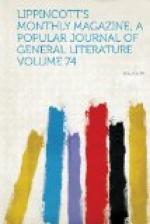would deem it sacrilege to deposit therein their dead
for corruption and decay; and hence have doubtless
originated their strange rites of sepulture, as they
believe that the body is thus more readily and rapidly
reduced to its original elements. Streams of water,
even the tiniest rivulets, are deemed too holy to
be desecrated by washing or spitting in them, and
still less would they make the water the receptacle
of offal of any sort. To each of these elements,
as well as to the fire, the Parsees still make oblations
on their high-days. It is true that their ceremonies
now are less imposing than those described by Xenophon,
when a thousand head of cattle were immolated at a
single festival, four beautiful bulls presented to
Jupiter, or the sky, and a magnificent chariot, drawn
by white horses crowned with flowers and wearing a
golden yoke, was offered to the sun; while the king
in his chariot was escorted by princes and great nobles,
two thousand spearmen marching on either side, and
three hundred sceptre-bearers, armed with javelins
and mounted on splendidly-caparisoned horses, bringing
up the rear. But those jubilant days have passed:
the Fire-worshipers are in exile, and have no king
to lead them, either in battle against their foes or
in triumphal processions in honor of their gods.
Yet is Parseeism not dead, nor even on the decrease.
Sacrifices, numerous and costly, are still piled upon
their altars, the finest cattle are dedicated to their
gods, the flesh being cut up and roasted for the people,
while the Magi cast the caul and a portion of the
fat into the fire as emblematic of the souls of the
victims being imbibed by the gods, while the grosser
portions are rejected.
The sacrifices and those who offer them are always
crowned with flowers, but the pontifical robes of
the Magi, though of pure white silk, are severely
plain in style and utterly devoid of ornament.
In their lives the Magi claim to practice a rigid
asceticism, making the earth their bed and subsisting
wholly on fruit, vegetables and bread, besides submitting
to frequent painful penances from fasting, scourging
and the endurance of fatiguing exercises. “Wine,
women and flesh” they are commanded to eschew
as “special abominations to those who aspire
to minister before the gods.” The most remarkable
feast of the ancient Parsees was one called by them
the “sack-feast.” On the appointed
day a condemned malefactor was clothed in royal robes,
seated on a kingly throne and the sceptre of regal
power placed in his hand. Princes and people
bowed the knee in mock homage before this king of
a day, and he was suffered to glut his appetite with
all manner of sensual delights till the sun went down,
and then he was cruelly beaten with rods, and forthwith
executed. (Were the crown and sceptre, the purple
robe and mock reverence, that were the antecedents
of the Redeemer’s crucifixion, a reproduction
of this barbarous custom?) The modern Parsees, though
recognizing this feast as a legitimate part of their




